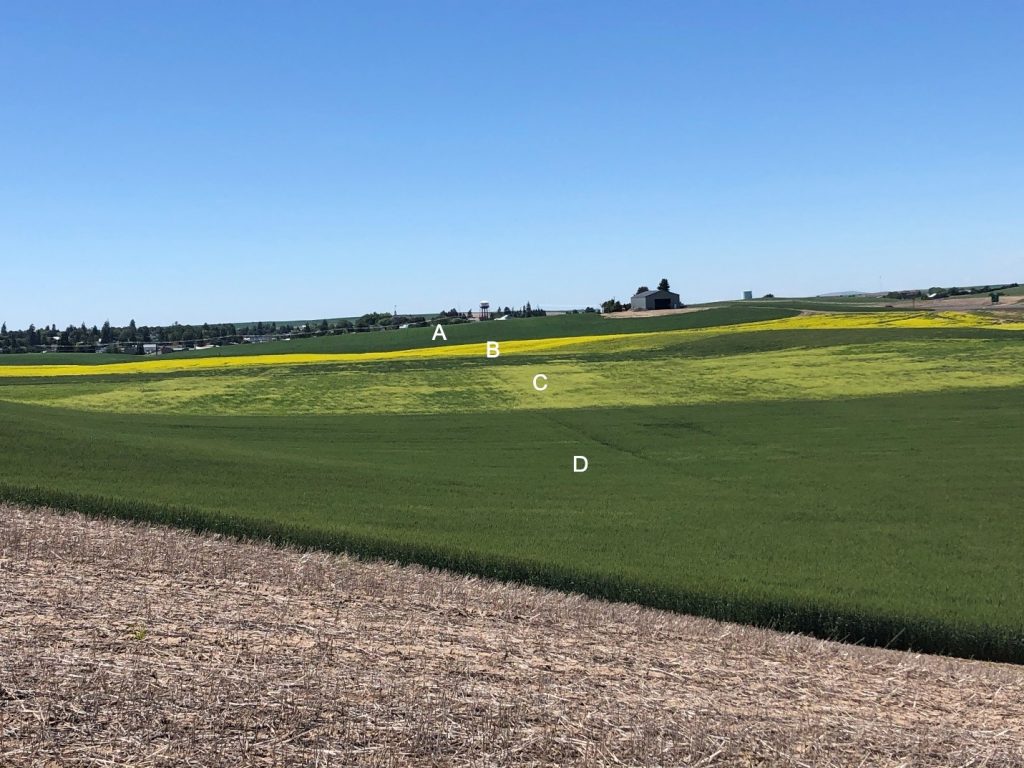June 22, 2020 was a beautiful day to take a walk across the WSU Wilke Research and Extension Farm near Davenport, Washington, and scout for weeds, take notes, and take some pictures of the farm. The spring canola (B) was in full bloom and both the winter (D) and spring (A) wheat were a nice dark green. The winter barley (C), however, was unique and told a much different story. It was an ugly mix of pale yellow because of a heavy population of Jim Hill mustard.
The story starts in the summer of 2019 with 2.20 inches of precipitation in August and September. Spring canola harvest in Field 4 just finished before the rains. Field 4 would traditionally be spring wheat fallowing canola but it was decided to take advantage of the precipitation and plant re-crop winter barley. Field 4 was sprayed with glyphosate at 32 oz/acre and 12 lb/100 gallons AMS Maxx on September 10, 2019. The field was seeded to ‘Saturn’ winter barley on September 17, 2019, at 66 lb/acre (1,000,000 seeds/acre). It was seeded with a John Deere 750 directseed disk drill on 7.5inch spacing, but there were issues with the hydraulic down pressure and consequently poor seed to soil contact. Stand establishment was assessed early in the spring and ‘Lenetah’ spring barley was interseeded into fifty percent of the field on April 7. Tricor DF (metribuzin) was applied at 3 oz/acre with 1 qt/100 gallons NIS on April 9, just two days after seeding. The plan was to come back after the spring barley was big enough and apply a broadleaf weed herbicide, however, the winter barley matured too quickly and no broadleaf herbicide was applied.

This unfortunate situation was a great learning opportunity. You see, in 2019 the large-scale spring canola variety trial was established in Field 4. The variety trial consisted of eight cultivars, four Roundup Ready (RR), one Liberty Link, two Clearfield tolerant, and one non-herbicide resistant cultivar. The cultivars were blocked by the herbicide-resistant trait to minimize spray injury. The RR cultivars had glyphosate applied, the Liberty Link cultivar had Liberty applied and the two Clearfield tolerant cultivars and the one non-herbicide resistant cultivar only received a single application of Assure II, a Group 1 grassy weed control herbicide. Beyond was not applied to the Clearfield tolerant cultivars because of the plant back restrictions.
Taking a closer look at the picture below you can pick out the three blocks that were RR and Liberty Link spring canola the previous year and the three blocks that were Clearfield and non-herbicide tolerant spring canola the previous year based on the Jim Hill mustard infestation. This really points out the value of weed control achieved in the previous crop and the impacts it has on subsequent crop production. It also points out how spring canola, and the unique herbicide-resistant weed control technology it brings to the field, can be valuable in an integrated cropping system.

Unique herbicide-resistant weed control technology in spring canola continues to advance and will assure it remains valuable. You are seeing terms like TruFlex RR canola, which allows greater labeled rates of glyphosate (up to 44 oz/ac) and has a much wider window for herbicide application. BASF submitted the cultivar ‘Invigor LR344PC LL-TF’ into the University of Idaho 2020 PNW Spring Canola Trial and it has both Liberty Link and TruFlex Roundup Ready traits. It also has very good yield potential across the region, ranking #9 out of 28 cultivars tested.
Have you made similar observations on your farm, regardless of the previous crop? Have you utilized spring canola in your cropping system lately? What is your level of interest in the latest round of spring canola technology? Check out the WSU Rotational Crops page to find the WSU Wilke Research and Extension Farm Operation, Production, and Economic Performance publications for additional information about the farm.